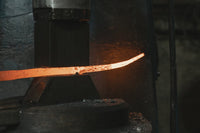If you’ve ever mixed up "wrought iron" and "rod iron," you’re not alone. It's a common confusion, but knowing the difference is really important—especially when you’re deciding on materials for construction or decorative projects. These two types of iron may sound similar, but they’re made differently, look different, and have different uses. In this blog, I’m going to break down the distinctions between wrought iron and rod iron so that you can make better, informed decisions about which one is right for your project.
What Is Wrought Iron?
Wrought iron has been around for thousands of years and was primarily used for tools, weapons, and construction because of its strength and durability. Wrought iron is made by heating and working iron (name comes from the old past tense of the verb "to work”) to remove most of the carbon, leaving a tough, malleable metal that’s strong but not brittle. This process gives it a distinctive fibrous texture, which also makes it resistant to corrosion and therefore ideal for decorative work.
Characteristics and Common Uses
- Low Carbon Content: Wrought iron has a low carbon content, making it more malleable and less brittle compared to other types of iron.
- Malleability: It's easy to shape and work, which is why it’s often used for custom designs in both functional and decorative applications.
- Strength: Wrought iron is strong and durable, capable of withstanding stress without breaking or deforming easily.
- Corrosion Resistance: The fibrous structure of wrought iron makes it more resistant to rust than other types of iron, especially when properly maintained.
- Texture: Wrought iron has a distinct wood-like grain, giving it a unique look and feel.
Common uses for wrought iron include home decor elements like stair railings, gates, and furniture, as well as structural components like fences and balconies. Its strength and ability to be shaped into intricate designs make it popular for both functional and decorative purposes. I like how it balances toughness with a classic, elegant appearance.
What Is Rod Iron?
Rod iron refers to a type of iron that has been shaped into thin, round bars or rods. Unlike wrought iron, which is worked to remove impurities and create a fibrous texture, rod iron is typically produced by rolling or drawing the iron into cylindrical shapes. Rod iron is often mistaken for wrought iron because the terms sound similar, and both types of iron were commonly used in the past.
Characteristics and Common Uses
- Basic Composition: Rod iron is typically cut from flat bars of iron and shaped into long, straight rods. It has a relatively simple structure and is not highly refined or processed.
- Functional Use: Historically, rod iron was used for basic construction purposes like making nails, hooks, or other simple tools. It wasn’t intended for decorative or intricate applications.
- Rigid and Straight: Unlike wrought iron, which is malleable, rod iron tends to be more rigid and less flexible, making it ideal for straightforward, functional uses where bending isn’t required.
- Lacks Decorative Appeal: Rod iron doesn’t have the same decorative or aesthetic qualities as wrought iron. It’s more practical and utilitarian in its application.
Side by Side Comparison: Wrought Iron vs Rod Iron
Strength and Durability
Wrought iron is stronger than basic iron rods, which makes it more durable and able to handle stress without breaking. It also resists rust better because it forms a natural layer that protects it from further corrosion. On the other hand, basic iron rods rust more quickly and can weaken over time without that protection. This makes wrought iron a better choice if you need something that will last longer, especially outdoors.
Appearance and Use
Wrought iron has a unique, handcrafted look that stands out because of the way it’s shaped into detailed, decorative designs. This gives it a classic and elegant appearance, perfect for gates, railings, and furniture. In contrast, iron rods are much simpler in appearance. They’re typically straight and basic, used more for functional purposes like construction or making nails. Iron rods don’t have the same visual appeal as wrought iron since they’re not designed for decorative use, making them less suitable for projects where aesthetics matter.
Manufacturing Process
The manufacturing process for wrought iron is much more labor-intensive compared to the simplicity of producing iron rods. Wrought iron is made by heating the metal and repeatedly hammering and shaping it, which requires a lot of craftsmanship and time. This process allows for intricate, custom designs and results in a more durable material. In contrast, iron rods are created by cutting flat iron bars into straight, simple shapes. This process is much quicker and easier, but it doesn’t offer the same level of detail or strength as the hand-forged wrought iron.
| Aspect | Wrought Iron | Rod Iron |
| Strength and Durability | Strong, durable, resists rust well. | Weaker, rusts quicker, less durable. |
| Appearance and Use | Handcrafted, decorative, elegant. | Simple, straight, mainly for construction. |
| Manufacturing Process | Labor-intensive, hand-shaped, custom designs. | Quick process, cut into rods, less detailed. |
How to Identify Real Wrought Iron
- Look for Hammer Marks: Since wrought iron is handcrafted, you’ll often see small hammer marks on the surface. These irregularities are a sign that the piece was shaped by hand, not made by a machine.
- Check the Grain Texture: Genuine wrought iron has a distinct grain that looks a bit like wood. This texture comes from the way the metal is worked, and it’s something you won’t find in mass-produced iron products.
- Feel the Weight: Wrought iron is heavier than many other metals or materials. If the piece feels lighter than expected, it might not be genuine wrought iron.
- Examine the Design: Wrought iron pieces are often intricate and detailed, as the material can be easily shaped into decorative patterns. Simple, plain designs might indicate a different type of iron or metal.

How to Pick the Right Iron for Your Decor: Tips for Homeowners
When choosing between wrought iron and rod iron for your home, it comes down to what you need. If you're looking for something decorative, wrought iron is the better choice. It's strong, durable, and has that handcrafted look. If you just need something simple and functional, like for basic structures or support, rod iron works fine. So, pick wrought iron if you want style, and rod iron if you need something more basic.
Conclusion
I hope this article helped clarify the differences between wrought iron and rod iron and provided useful information to guide your decision. If you want to explore more about iron railings or get expert advice, feel free to visit our site at SI Handrails. We’re always here to assist with your questions and help you find the best fit for your home.









